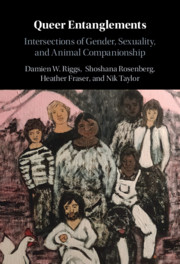Book contents
- Queer Entanglements
- Queer Entanglements
- Copyright page
- Contents
- Figures
- Acknowledgements
- Frontispiece
- 1 Menageries, Enmeshment, and Irreducibility
- 2 Love, Loss, and Grief
- 3 Violence, Cruelty, and Rescue
- 4 Sameness, Difference, and Intercorporeality
- 5 Rainbows, Flags, and Bridges
- 6 Consumption, Consumerism, and Kink
- 7 Voice, Responsibility, and Liberation
- References
- Index
3 - Violence, Cruelty, and Rescue
Published online by Cambridge University Press: 09 July 2021
- Queer Entanglements
- Queer Entanglements
- Copyright page
- Contents
- Figures
- Acknowledgements
- Frontispiece
- 1 Menageries, Enmeshment, and Irreducibility
- 2 Love, Loss, and Grief
- 3 Violence, Cruelty, and Rescue
- 4 Sameness, Difference, and Intercorporeality
- 5 Rainbows, Flags, and Bridges
- 6 Consumption, Consumerism, and Kink
- 7 Voice, Responsibility, and Liberation
- References
- Index
Summary
In this chapter, we explore how LGBQTNB people are affected by intersections of human- and animal-directed violence. We start by outlining how research in the field of human–human domestic violence has long recognised the relationship between such violence and human–animal cruelty in the domestic sphere but argue that rarely, however, has research on ‘the link’ focused on LGBQTNB people. From the international survey and interview data considered in this chapter, what is evident is that many LGBQTNB people see animal companions as uniquely able to recognise and honour human diversity. As a result, the threat of animal cruelty strikes a particular chord for human LGBTQNB victims of domestic violence: It speaks to the very point of identification that produces a sense of being uniquely recognised and honoured. As we have argued elsewhere, the idea of ‘rescuing’ animals from dire situations is always paired with the potential that animal companions will help to rescue humans from their own dire situations. In a broader context of discrimination, the recognition and honour seemingly accorded by animals offer lifelines to many. Yet, in the context of violent human–human relationships, the lives of humans and animals are at risk. How the survey and interview participants account for this enmeshment of risk and rescue thus sits at the very heart of this chapter.
- Type
- Chapter
- Information
- Queer EntanglementsIntersections of Gender, Sexuality, and Animal Companionship, pp. 64 - 89Publisher: Cambridge University PressPrint publication year: 2021



